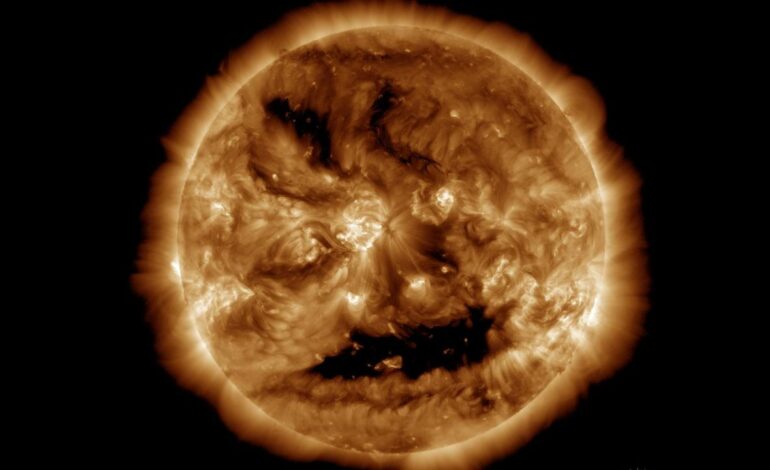NASA Captures Halloween-Inspired Face on the Sun

NASA’s Solar Dynamics Observatory (SDO) has captured a striking image of the sun resembling a jack-o’-lantern, just in time for Halloween. The photograph, taken on October 28, 2023, showcases a haunting grin formed by bright active regions and dark coronal holes on the sun’s surface.
The image, produced by SDO’s Atmospheric Imaging Assembly (AIA) at a wavelength of 193 angstroms, highlights how natural phenomena can create eerie visuals. The coronal holes appear like glowing eyes and a mischievous smile, while the “mouth” of the jack-o’-lantern is identified as a vast coronal hole. This area allows charged particles to escape into space, contributing to solar wind.
Potential Geomagnetic Storms
This specific coronal hole is currently sending a high-speed stream of solar wind toward Earth. According to space weather forecasters, this could lead to minor (G1) to moderate (G2) geomagnetic storm conditions from October 28 through October 29. Such storms can enhance auroral activity, allowing the northern lights to be visible further south than usual.
Historically, significant solar activity has led to remarkable auroras. For instance, 22 years ago during the infamous Halloween storms of 2003, a series of powerful solar eruptions caused widespread disruptions to satellites and power systems, while also triggering spectacular displays of the aurora borealis.
Importance of Solar Monitoring
The SDO has been observing the sun since its launch in 2010, providing continuous, high-resolution data that aids scientists in understanding the sun’s magnetic energy and its impact on space weather. This information is crucial for predicting how solar activity can influence life on Earth.
This isn’t the first instance of the observatory capturing a spooky face on the sun. In 2014, it documented a similar jack-o’-lantern-like formation, showcasing the sun’s ability to surprise and engage our imagination.
The ongoing observations by NASA not only enhance our understanding of solar phenomena but also enrich our appreciation for the dynamic and often surprising nature of our closest star.






